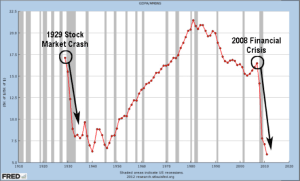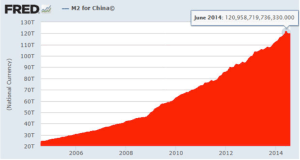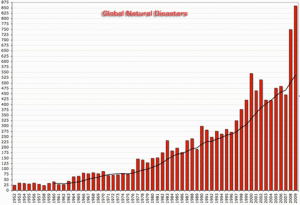Capitalism Crosses The Rubicon
The Second American Revolution Darryl Robert Schoon
Posted May 26, 2015 In capitalist economies, capital, i.e. ‘money’, is created by central banks in the form of credit; and the cost of that credit—central bank interest rates—determines the rate of economic growth. In the end game, however, this is not so. In the end game, credit’s expansive and inflationary incentives are offset by the collapse of massive speculative bubbles resulting in dangerously low levels of economic activity and a commensurate plunge in the velocity of money. When this happens, central banks cut interest rates hoping that cheaper credit will revive growth. But, in the end game, attempting to revive growth by lowering the cost of credit is like pushing on a string; a phrase used in 1935 when Fed Governor Marriner Eccles was asked about Fed attempts to revive the US economy.
[Fed] Governor Eccles: Under present circumstances there is very little, if any, that can be done. Congressman Goldsborough: You mean you cannot push on a string. [Fed] Governor Eccles: That is a very good way to put it, one cannot push on a string. We are in the depths of a depression and… beyond creating an easy money situation through reduction of discount rates, there is very little, if anything, that the reserve organization can do to bring about recovery. In the 1920s, excessive monetary creation by the Fed fueled an historic stock market bubble. The greed and speculation ended on October 29, 1929 when the bubble burst, stocks plummeted, banks closed, savings were lost and unemployment soared—plunging the US into the Great Depression of the 1930s. (Click on images to enlarge)  Deflationary depressions are always and everywhere a monetary phenomenon. Excessive monetary growth creates large speculative bubbles, the bubbles burst and economic growth collapses, even when the quantity of money is increased. This is—always and everywhere—the cause of deflationary depressions. -DRSchoon, Neo-Friedman Monetarism in an Age of Monetary Debasement FUEL FOR ANOTHER DEFLATIONARY DEPRESSION US Money Supply, 1980 – 2012  PAST AND FUTURE DEPRESSIONS In 1933 to prevent another Great Depression, the US Congress passed the Glass-Steagall Act. By separating investment banking (leveraged betting) from commercial banking (savings & loans), banks were legally prevented from betting the savings of America as they had in the 1920s. In 1933, the U.S. Congress passed the Glass–Steagall Act mandating a separation between commercial banks, which take deposits and extend loans, and investment banks, which underwrite, issue, and distribute stocks, bonds, and other securities. Read here. In 1999, in a rare bipartisan effort, a Republican Congress and a Democrat President, Bill Clinton, repealed Glass-Steagall; allowing investment bankers to once again place dangerously leveraged bets using America’s savings in Wall Street casinos. Bipartisan usually means that a larger-than-usual deception is being carried out. -George Carlin Between 1999 and 2008, Wall Street banks again bet America’s savings and again lost—this time with dodgy bets on suspect subprime mortgages; triggering the greatest financial crisis since the crash of 1929. Once again banks closed, economic activity plummeted and the velocity of money plunged. THE VELOCITY OF MONEY  THE FIVE PERCENT SOLUTION On May 6, 2015, Stephen King, chief economist at HSBC, wrote in a note to HSBC clients: The world economy is like an ocean liner without lifeboats. If another recession hits, it could be a truly titanic struggle for policy makers… Whereas previous recoveries have enabled monetary and fiscal policymakers to replenish their ammunition, this recovery — both in the US and elsewhere — has been distinguished by a persistent munitions shortage. This is a major problem. In all recessions since the 1970s, the US Fed funds rate has fallen by a minimum of 5 percentage points. That kind of traditional stimulus is now completely ruled out. -Stephen King, Chief Economist HSBC, read here. In 2006, the Fed funds rate was 5.25%. After the 2008 financial crisis, the Fed lowered the discount rate to 0.00 – 0.25%, the 5 percentage point traditional stimulus at which economies regain inflationary momentum. They didn’t. We have global bond yields going back to the 16th century and only in the 1570s and 1930s have yields been as low as they have been in recent months. -David Rosenberg, May 6, 2015 Today, after six years of zero interest rates, the specter of another deflationary depression is growing in every advanced, i.e. overly-indebted, economy in the world—the US, the UK, the EU, Japan, China, etc. Offered zero rate sovereign bonds as an investment, investors are choosing to invest in negative rate bonds hoping against hope that central bankers can restore the requisite balance between credit and debt necessary for their ponzi-scheme to survive. Arbitraging the cost of capital doesn't work when capital is free Central banks have now, quite literally, bet the bank. However, once quiescent deflationary forces, awakened by the collapse of the 1990 Japanese Nikkei, the 2000 US dot.com and 2008 US real estate bubbles, are about to be further inflamed by the coming collapse of China’s real estate and stock market bubbles. FUEL FOR THENEXT DEFLATIONARY DEPRESSION China’s monetary growth  Deflationary depressions are always and everywhere a monetary phenomenon. Excessive monetary growth creates large speculative bubbles, the bubbles burst and economic growth collapses, even when the quantity of money is increased. This is—always and everywhere—the cause of deflationary depressions. -DRSchoon, Neo-Friedman Monetarism in an Age of Monetary Debasement Hanging by a noose
Pushing on a string
Bankers wondering what
Tomorrow’s going to bring THE MOTHER OF ALL PARADIGM SHIFTS Humanity is in the midst of a historic and momentous paradigm shift. Governments will fall, natural disasters will increase and the present world will pass away, paving the way for the better world to come. -DRS, Silver – the Canary in the Gold Mine, April 11, 2011 …the number of natural and geophysical disasters taking place each year is noticeably skyrocketing…In 1970, the average of natural disasters that were reported was 78; in 2004, this number jumped to 348. Read here. On May 18, 2015, Andrew Freedman wrote: It’s only May, which means the tropical cyclone season in the Northern Hemisphere is still in its infancy. The Atlantic season doesn't officially start until June 1, after all…Yet already, in just the first four-and-a-half months of the year, the planet has had more Category 5 storms — the most destructive category — than its average annual total of such powerful tempests.  The increasing number of natural disasters is a part of a far larger paradigm shift now taking place. Triggered in part by the current economic crisis, the fundamental changes will affect political, cultural, religious and economic institutions on a global scale. On May 15th, Eric King interviewed David Stockman regarding the collapse of the present monetary system and the role of gold in such times: … when a monetary system finally fails, there will be a flight to the only money that’s left in the system and that will be gold. That will be the hour in which the next great surge in the gold price occurs. You can’t predict the exact moment, but you can certainly have a pretty confident view of the direction (parabolic). The central banks are clearly destroying the monetary system that emerged after Nixon went to Camp David in August, 1971. So here we are 45 years later and we are nearing the end of an unstable fiat central bank driven system and the alternative is fairly obvious — at some point going back to real money [gold]. I don’t think governments will do that voluntarily, but certainly people trying to protect their wealth will. When that happens it will trigger a huge political crisis and hopefully an opportunity to change the regime and get back to some kind of viable and sound financial and monetary system. Read here.
My youtube video, America 2.0 – the Second Revolution, discusses America’s current political crisis and what I believe is going to happen. The present system is untenable and the future cannot yet be seen; and, yet, whether we know it or not, humanity is part of something far greater than it knows and/or believes. You can bank on it.
Buy gold, buy silver, have faith. ### Darryl Robert Schoon
email: info@drschoon.com
website: www.drschoon.com
website: www.survivethecrisis.com
Schoon Archive
 About Darryl Robert
Schoon About Darryl Robert
Schoon
In college,
I majored in political science with a focus on East Asia (B.A.
University of California at Davis, 1966). My in-depth study of
economics did not occur until much later.
In the 1990s,
I became curious about the Great Depression and in the course
of my study, I realized that most of my preconceptions about money
and the economy were just that - preconceptions. I, like most
others, did not really understand the nature of money and the
economy. Now, I have some insights and answers about these critical
matters.
In October 2005,
Marshall Thurber, a close friend from law school convened The
Positive Deviant Network (the PDN), a group of individuals whom
Marshall believed to be "out-of-the-box" thinkers and
I was asked to join. The PDN became a major catalyst in my writings
on economic issues.
When I discovered
others in the PDN shared my concerns about the US economy, I began
writing down my thoughts. In March 2007 I presented my findings
to the Positive Deviant Network in the form of an in-depth 148-page
analysis, "How to Survive the Crisis
and Prosper In The Process."
The reception
to my presentation, though controversial, generated a significant
amount of interest; and in May 2007, "How To Survive The
Crisis And Prosper In The Process" was made available at
www.survivethecrisis.com and I began writing
articles on economic issues.
The interest
in the book and my writings has been gratifying. During its first
two months, www.survivethecrisis.com was accessed by over 10,000
viewers from 93 countries. Clearly, we had struck a chord and
www.drschoon.com, has been created to
address this interest. 321gold Ltd

|